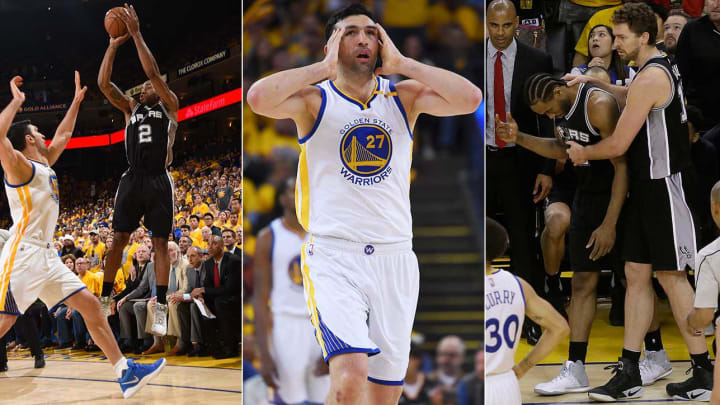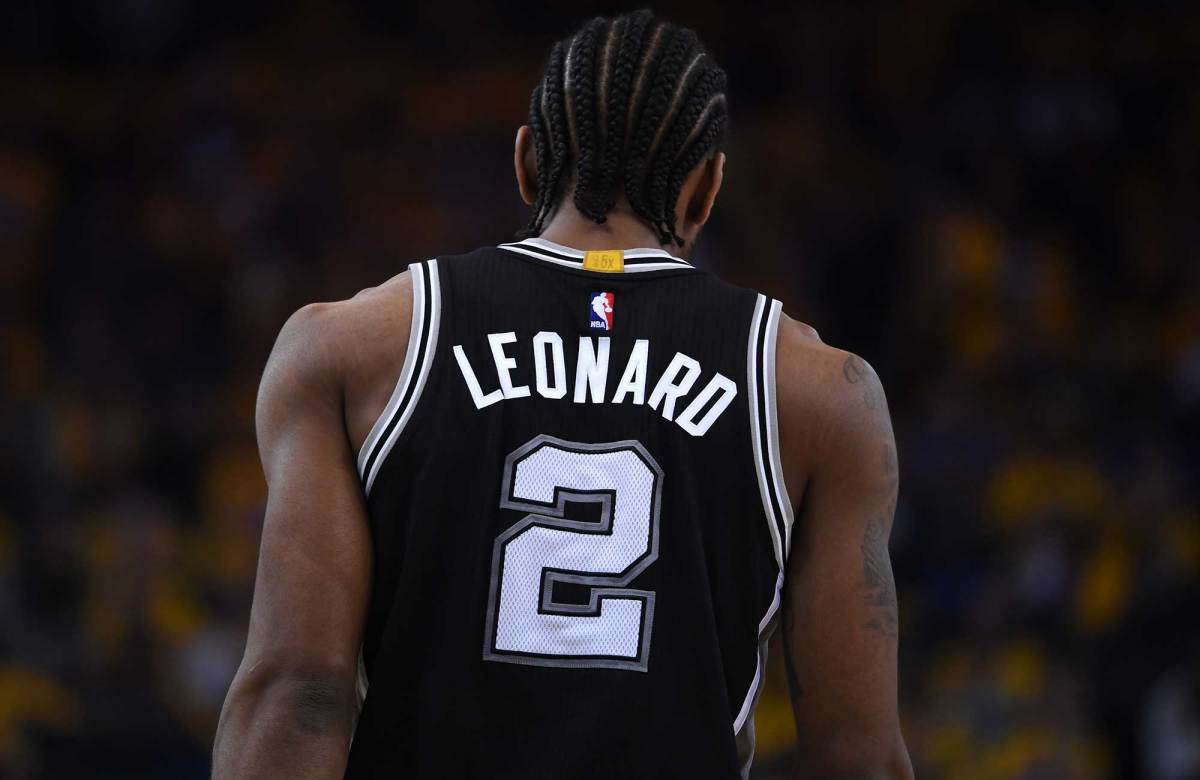The NBA's 'Slide Under' Epidemic Claims Kawhi

OAKLAND, Calif. — On an afternoon that featured one of the most debated fouls in recent memory, these facts should be indisputable: The Spurs were on track for a shocking Game 1 upset, Kawhi Leonard was playing like an MVP, and the truly unfortunate re-injury of his ankle cast a cloud over the Warriors’ sensational 25-point comeback victory. Here, following the richest game of the 2017 NBA playoffs, ZazaPachulia found himself surrounded by reporters and television cameras demanding an answer to a question that had been circulating on social media for hours: Did the Warriors center mean to injure Leonard by sliding underneath him while closing out on a jump shot?
“That’s really stupid,” Pachulia said, looking annoyed at the perceived attack on his character. “I hate anybody going down with an injury like that. I’m an athlete too.”
But here’s what’s really, really stupid: That the heated post-game discussion devolved into a granular investigation of Pachulia’s intent, rather than a big-picture look at his action. In the dueling rushes to either tar-and-feather Pachulia for unsportsmanlike conduct or absolve him against claims of dirtiness, a more important point got lost in the shuffle.
No shooter should ever have to worry about a defender sliding under him. Period.
The Warriors Got Lucky In Game 1. So What?
This isn’t just about Pachulia, whose “extra step” underneath Leonard on his closeout incensed many viewers. To be clear, Leonard told reporters that he felt Pachulia hadn’t injured him “on purpose,” and the Spurs players and coach Gregg Popovich opted against taking issue with the closeout immediately after Game 1. (Update: Popovich said that Pachulia's closeout was "unsportsmanlike" regardless of his intent on Monday.) Meanwhile, the Warriors stood by their man, with Kevin Durant saying that Pachulia is “not a dirty player” and critics voicing complaints about the play on Twitter were “irrational.”
Pachulia’s best defense is actually his real-time reaction. After being called for a foul on the play, he took off galloping towards midcourt with his hands near his head in total disbelief. Durant rightfully pointed out that Pachulia would have had to “time that perfectly” to injure Leonard, and he would have needed serious acting chops to morph from ankle-busting sniper into aggrieved victim in three seconds flat.

Zoom out. The “slide under” happens at every level of basketball. Pick-up players across the globe winced knowingly when ABC’s baseline camera caught Leonard grasping at his left ankle in clear pain. The “slide under” happens so often that players like Bruce Bowen and Dahntay Jones have been branded with scarlet letters for repeat offenses or high-profile incidents.
The “slide under” happens so often that the NBA’s online video rulebook has a clip specifically devoted to the foul entitled, “Defensive Player undercuts airborne shooter.” In the accompanying video, the shooter suffers a sprained left ankle, just like Leonard, thanks to a defensive player’s closeout. “Defenders may not move into the landing area of an airborne shooter,” the narrator says. “Whether intentional or not, this is a dangerous play and will be penalized.”
Indeed, Pachulia was penalized. Referee Marc Davis watched the entirety of Leonard’s shooting motion and correctly whistled Pachulia for the foul. In an NBA TV interview, NBA senior VP of replay and referee operations Joe Borgia praised Davis’s call. “We see this quite often in the NBA,” Borgia said. “That defender just goes a little too far. You’re not allowed to take the landing area away from the jump shooter. Obviously a very dangerous situation for players. The referee luckily stayed on that play all the way until the shooter landed.”
The word that should pop out, both from the NBA’s online rulebook and from Borgia’s description, is “dangerous.” Leonard is as finely-tuned a professional athlete as there is in the world, a strong, savvy and focused All-Star forward who often gets compared to a machine and a robot because of his unrelenting style and restrained personality. But Leonard is a human being, and he is a completely vulnerable human being when he enters the act of shooting. With his attention split between the basket, the defender(s) around him, and his spacing relative to the three-point line and the sideline/baseline, Leonard can’t also be expected to plan for a safe and injury-free landing. The NBA clearly understands this, which is why Pachulia was assessed a foul.
Will Warriors-Spurs Save The NBA Playoffs?
However, the league must ask itself this tough question: Does the punishment for this admittedly “dangerous” act fit the crime? Especially when Leonard—who already missed the end of Game 5 and all of Game 6 against the Rockets in the second round with an ankle injury—might be out for Game 2 on Tuesday? Two or three shots? That’s it? For an act that doesn’t belong in the sport, one that, in this case, has the potential to sideline a star and directly impact the title chase?
Remember, the NBA’s definition of a flagrant foul 1 is “unnecessary contact” regardless of intent. Even stripped of potential malice, Pachulia’s contact was certainly unnecessary. He might have wanted to challenge Leonard’s shot, but his action was as “dangerous” as other unintentional flagrant fouls, like following through during a block attempt to hit an opponent in the head or delivering a weighty bump in transition that sends someone flying into the baseline crowd.
At a minimum, then, the NBA should treat undercutting airborne shooters as a flagrant foul 1, subject to confirmation by a video review. A flagrant foul 2, which mandates an ejection for “unnecessary and excessive,” might be even more appropriate in some situations. The league should also consider fines and/or a one-game suspension for undercuts that lead directly to injuries or repeated undercuts by the same player.
Without stiffer penalties, defenders are free to flirt with the gray area of play psychological mind games as they have for years. Without stiffer penalties to deter and hopefully significantly reduce these plays, stars like Leonard are at risk of cheap play and the league must cope with the knowledge that it could have done more to eliminate an act that it knew was dangerous and that wound up altering a long-awaited playoff showdown.

There may be some who believe that it’s a mistake to overreact to Leonard’s sprained ankle. Yes, this was a nightmare scenario. How often will a consensus top-five player be forced from action during a pivotal conference finals game between two powers that have spent years circling each other? How often will that player’s impact be as indisputable as Leonard’s given that he was +21 in 24 minutes and the Spurs were -23 in their 24 minutes without him? How often will a team as star-studded as Golden State be scared by a pesky underdog quite like this?
The Warriors' Deadly Combo Of Hustle And Flow
The counter to those questions is simple: One time was already too many. When Paul George broke his leg by crashing into a basket stanchion during an exhibition in 2014, USA Basketball identified the problem and smartly moved the stanchions back as a logical solution. The NBA followed suit soon after, reducing the number of baseline photographers to ensure that players had more landing room on drives. While Leonard will surely return to this series soon—rather than face the extended rehabilitation that George endured—his injury should prompt a similar institutional response aimed at improving player safety.
Pachulia will be the villain of the day for his sloppy footwork, but the greater misdeed is recognizing a serious problem and not doing enough to address it. The NBA’s worst fears about the danger of the “slide under” were confirmed Sunday, and the league must respond with appropriate action and penalties to ensure that Leonard and other jump-shooters aren’t left hung out to dry in the future.
During an era in which the three-pointer has played a major role in driving the league’s financial boom, this should be an easy point of emphasis: Let shooters shoot without fear of injury.
